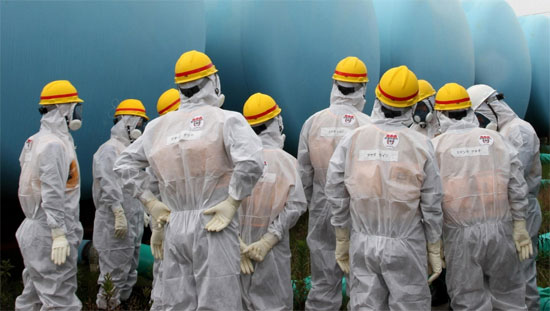Contaminated water at Fukushima enters groundwater
The Tokyo Electric Power Company (TEPCO) said on September 5 that it detected a concentration of 650 becquerel per liter of groundwater near a tank that leaked water at the Fukushima Power Plant No.1.
>>>Japan spent over 400 million USD cleaning Fukushima
The detection of strontium and other beta rays showed the possibility of radioactive water from the reservoir sinking into the groundwater. Previously, TEPCO had reported about 300 tons of highly contaminated water leaked from this tank.
TEPCO said it took a sample of groundwater on September 4 in a well that was more than ten meters deep on the south side of the tank in H4 area where the water leak occurred.

Staff of the Japanese Nuclear Regulators near the radioactive water tanks at the Fukushima Daiichi power plant.(Source: EPA)
The radioactive concentration of groundwater found lower than the contaminated water in the tank may have been diluted by rainwater.
TEPCO believes that most of the leaked toxic water seeps into the soil and flows partly to the sea through a nearby sewer. It is not clear how much water is flowing into the sea.
The Japanese government plans to use water wells to pump groundwater into the sea before it enters the reactor-containing building to reduce about 400 tons of groundwater currently flowing into buildings every day.
The construction of the ice wall is also being planned to prevent water flow. However, according to the latest measurements, water in some wells is worried that it may also be contaminated.
- The contaminated water in Fukushima 1 is suspected of being absorbed into the Pacific Ocean
- Freezing lands around Fukushima factory
- Fukushima leaked contaminated water from the No. 1 storage tank
- Groundwater in Japan is 10,000 times more contaminated
- Close to the radiation water crisis in Fukushima
- Discovered more leakage of contaminated water in Fukushima 1
- Contaminated water is flowing into the Fukushima building 1
- Japan spent over 400 million USD cleaning Fukushima
- 300 tons of contaminated water leaked out
- Hanoi underground water 'arsenic contamination' to foreign newspapers
- Japan intends to vaporize contaminated water in Fukushima
- Japan blocked the leak of contaminated water into the Pacific Ocean
 Is the magnetic North Pole shift dangerous to humanity?
Is the magnetic North Pole shift dangerous to humanity? Washington legalizes the recycling of human bodies into fertilizer
Washington legalizes the recycling of human bodies into fertilizer Lightning stone - the mysterious guest
Lightning stone - the mysterious guest Stunned by the mysterious sunset, strange appearance
Stunned by the mysterious sunset, strange appearance